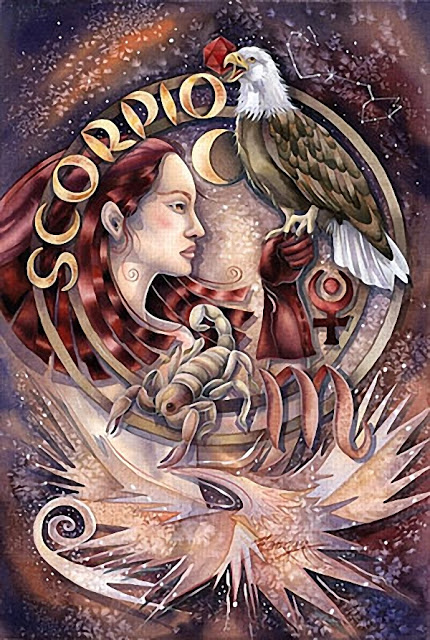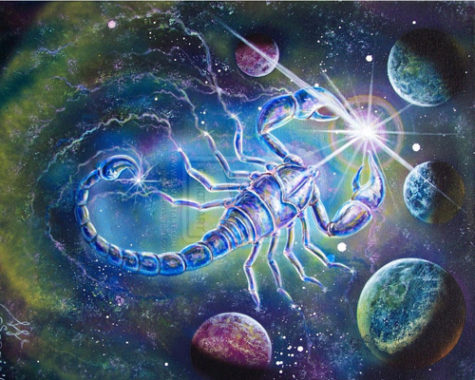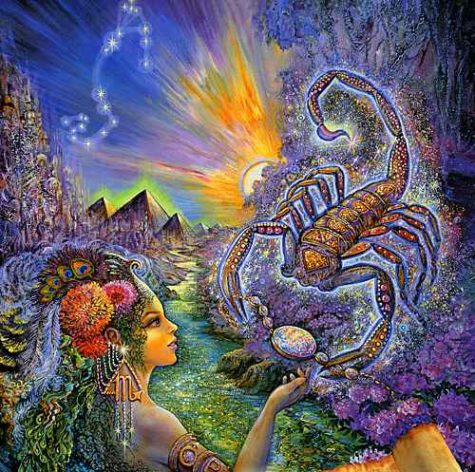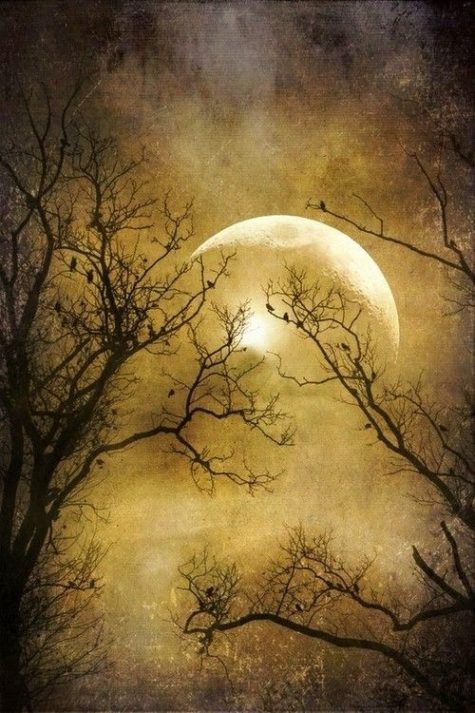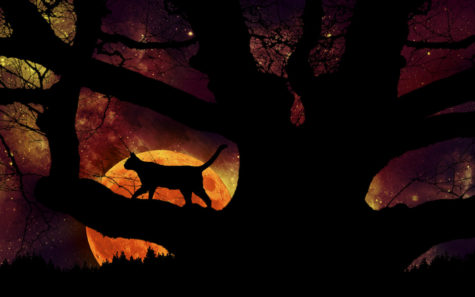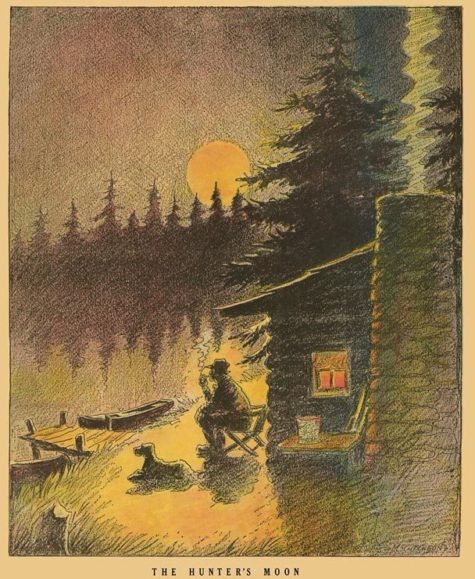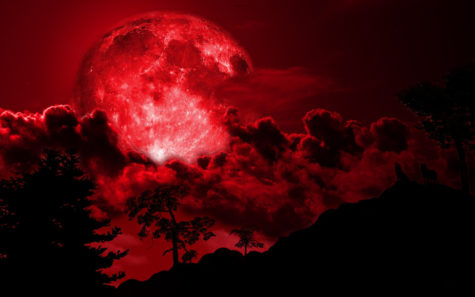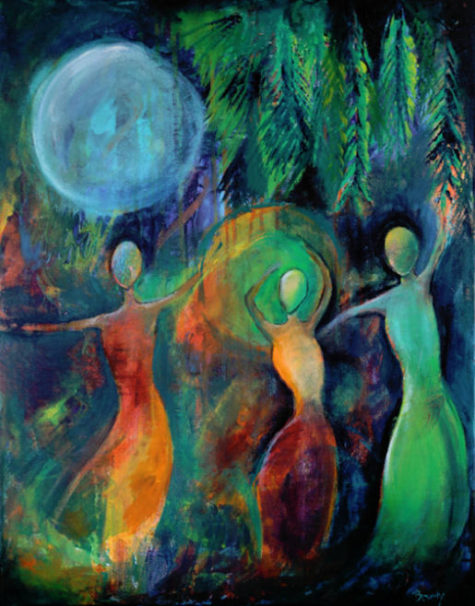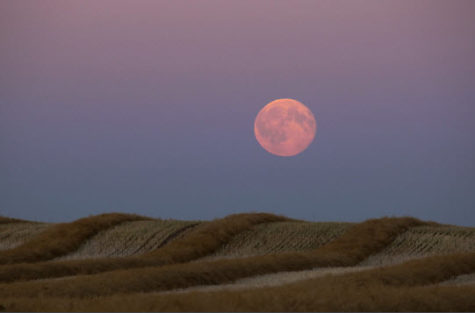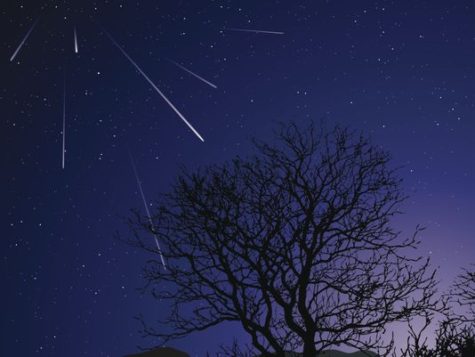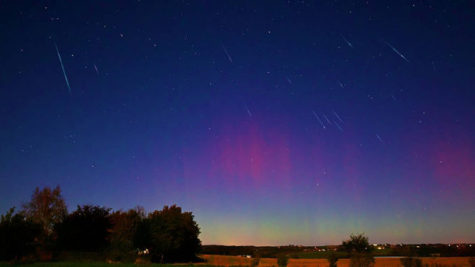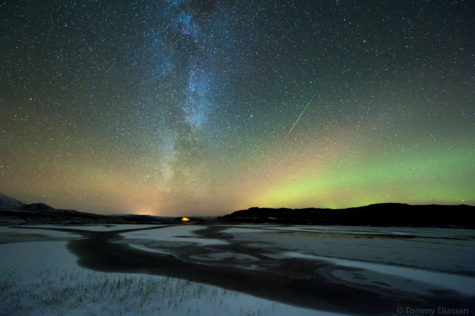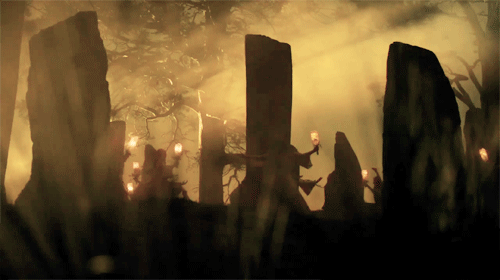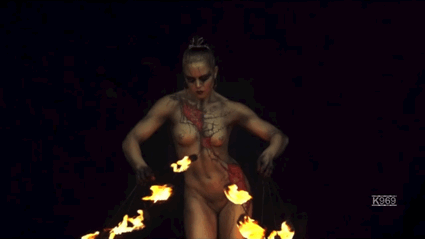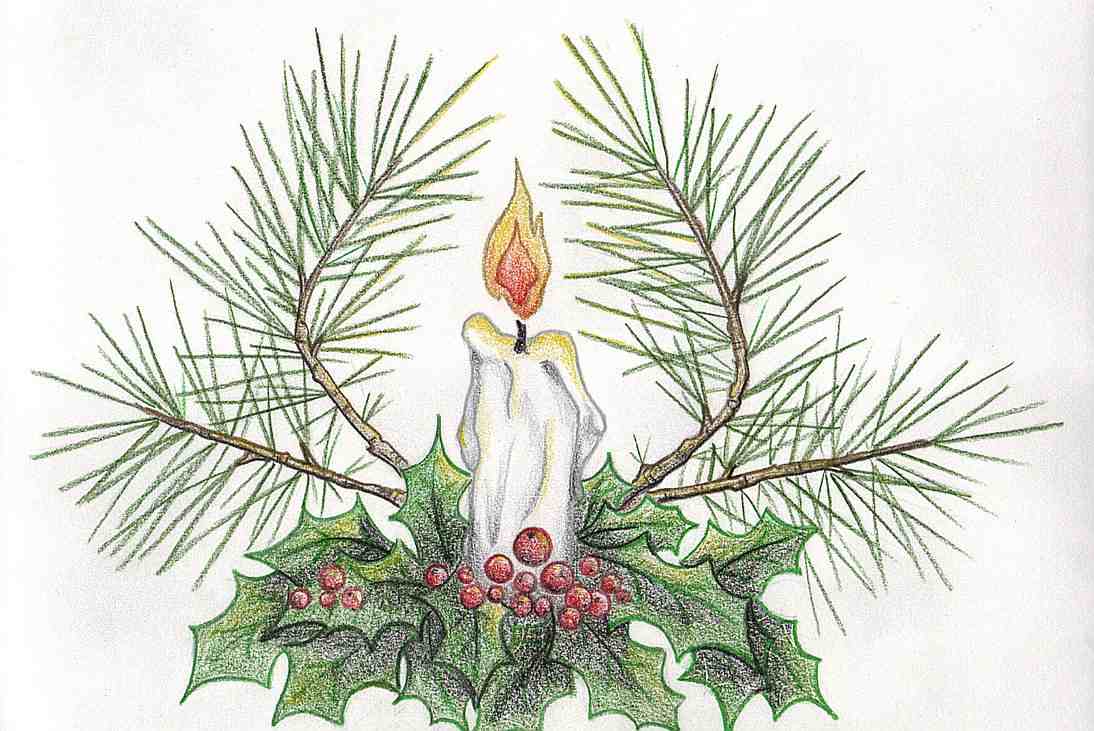October Skies
Scorpio is the eighth sign of the zodiac. The sun enters Scorpio at slightly different times each year, usually around Oct 22, sometimes the day before or the day after.
- Symbol: Scorpion
- Element: Water
- Gemstone: Topaz
- Keword: I Desire
Scorpios are forceful, determined, secretive, and emotional. They are naturally intuitive, and instinctively know what makes other people work. However, they keep their own motivations and true nature a secret. Scorpios are patient people who wait for opportunities and then act quickly, using surprise to their benefit. Scorpios usually know what they want, and they invariably achieve their goals in the end.
From 365 Goddess, we have this for today:
- Themes: Creativity; Sexuality; Passion; Instinct; Fire; Energy
- Symbols: Scorpion (or any stinging, hot items)
- Presiding Goddess: Isara
About Isara:
An ancient Mesopotamian goddess, Isara is known for her fiery nature. The Syrians specifically worshiped her in the form of a scorpion when they wished to improve sexual prowess or passion. In other traditions, Isara judges human affairs fairly but firmly, and all oaths made in her name are sacred.
To Do Today:
In astrology, people born under the sign of Scorpio are said to be creative, tenacious, sturdy, and sensuous, often internalizing Isara’s fire in their sign for personal energy. To do likewise, enjoy any hot beverages (such as coffee with a touch of cinnamon for vitality) first thing in the morning. This will give you some of Isara’s fire to help you face your day, both mentally and physically.
For those wishing to improve interest or performance in the bedroom, today is a good time to focus on foods for passion and fecundity. Look to bananas or avocados in the morning, olives, dill pickles, radishes, or licorice sticks as a snack, beans as a dinner side dish, and shellfish as a main platter. Remember to invoke Isara’s blessing before you eat. And, if you can find one, put the image of a scorpion under your bed so that Isara’s lusty nature will abide in the region and you can tap into it during lovemaking.
More About the Sun in Scorpio
The Sun is in Scorpio from approximately October 23 to November 21, depending on the year.
- Ruler: Pluto, Mars
- Modality: Fixed
- Season: Fall
- Metal: Steel, Iron
- Stone: Topaz, Opal
- Color: Gold, Purple
- Flowers: Chrysanthemum; Pansy
- Anatomy: Genital organs, bladder, bowels
- Attributes: passionate, perceptive, resourceful, possessive, psychological, prowling, determined, probing, fixed, focused.
Scorpios are known for their intensity. They are determined folk that absolutely throw themselves into whatever they do — but getting them to commit to something is rarely an easy task. In fact, it’s better not to even try to “get them” to do anything. Solar Scorpios absolutely have their own mind. And, their primary motivation is unlikely to be prestige (like their Capricorn friends), or even authority (Leos can have that, too)–it’s real power. Their power can absolutely be of the “behind the scenes” variety, just as long as they have it.
To others, Scorpios seem to have plenty of willpower. They probably do. Scorpios do know what they want, and they won’t go out and grab it at the wrong moment. They simply sit back, watch (quite expertly), and then get it only when the moment is just right. This apparent patience is simply their powerful skills at strategy at work.
Scorpio isn’t afraid of getting their hands (their bodies, their minds) dirty. The darker side of life intrigues them, and they’re always ready to investigate.
Scorpios simply never give up. They have tremendous staying power. They’re not in the slightest intimidated by anybody or anything. Confrontations are not a problem. In fact, talk to any Scorpio about their lives, and you’ll probably be in awe at all they’ve gone through. Trauma seems to follow them wherever they go. When Scorpio learns optimism, instead of expecting the worst, they’ll find that they possess amazing regenerative powers — the power to heal, create, and transform.
Source: Cafe Astrology
What follows is a list (in alphabetical order) of the names given to the October moon. Also listed is the tradition and/or origin of that moon name:
- Blood Moon ~Mediaeval English, Neo-Pagan
- Blood Moon Falling ~Janic (full)
- Corn Ripe Moon ~Taos
- Falling Leaves Moon ~Arapaho
- Full Dying Grass Moon ~Algonquin Native American, Colonial
- Harvest Moon ~When closest to the Autumnal Equinox
- Hunter’s Moon ~Neo-Pagan, Algonquin, Native American, Colonial
- Kentenha ~Mohawk
- Leaf Moon ~Janic (dark)
- Leaf Fall Moon ~San Juan, Native American
- Long Hair Moon ~Hopi
- Moon of the Changing Season ~other
- Shedding Moon ~other
- Snow Moon ~other
- Spirit Moon ~other
- Ten Colds Moon ~Kiowa
- Travel Moon ~Algonquin, Native American, Colonial
- Tugluvik ~Inuit
- Vintage Moon ~other
- White Frost Moon ~other
- Windermanoth ~other
- Wine Moon ~Mediaeval English
- Winterfelleth Moon ~other
- Winter’s Coming Moon ~other
The Hunter’s Moon is so named because plenty of moonlight is ideal for hunters shooting migrating birds in Northern Europe. The name is also said to have been used by Native Americans as they tracked and killed their prey by autumn moonlight, stockpiling food for the winter ahead.
Traditional association with feasting:
In the northern hemisphere, the Hunter’s Moon appears in October or November, usually in October. Traditionally, it was a feast day in parts of western Europe and among some Native American tribes, called simply the Feast of the Hunter’s Moon, though the celebration had largely died out by the 18th century. There is a large historical reenactment by that name in Lafayette, Indiana during the early part of October 2010
Variation in time of moonrise:
In general, the moon rises about 50 minutes later each day, as it moves in orbit around Earth. All full moons rise around the time of sunset. The Harvest Moon (full moon closest to the Autumnal Equinox) and Hunter’s Moon are special because — as seen from the northern hemisphere — the time of moonrise on successive evenings is shorter than usual. The moon rises approximately 30 minutes later, from one night to the next, as seen from about 40 degrees N. latitude, for several evenings around the full Hunter’s or Harvest Moons.
Thus there is no long period of darkness between sunset and moonrise, around the time of these full moons. In times past, this feature of these autumn moons was said to help hunters tracking their prey (or, in the case of the Harvest Moon, farmers working in the fields). They could continue tracking their prey (or bringing in their crops) by moonlight even when the sun had gone down. Hence the name Hunter’s Moon.
The reason for the shorter-than-usual rising time between successive moon rises around the time of the Harvest and Hunter’s Moon is that the orbit of the Moon makes a narrow angle with respect to the horizon in the evening in autumn, leading the Moon to higher positions in the sky each successive day.
Brightness and distance:
The Hunter’s Moon is not brighter, smaller or yellower than during other times of the year, but all full moons have their own special characteristics, based primarily on the whereabouts of the ecliptic in the sky at the time of year that they are visible.
The full moons of September, October and November, as seen from the northern hemisphere — which correspond to the full moons of March, April and May as seen from the southern hemisphere — are well known in the folklore of the sky.
Since the Moon’s sidereal period differs from its synodic period, the perigee of the Moon (the point where it is closest to the Earth) does not stay in sync with the phases of the Moon. Thus the Hunter’s Moon does not correspond to any special timing of the Moon’s distance from the Earth. This is why the Hunter’s Moon is not, in general, brighter than any other regular full moon.
Source: Wikipedia
October’s full moon is often referred to as the Blood Moon, or Sanguine Moon. The Blood Moon takes its name not from blood sacrifices, but from the old custom of killing and salting down livestock before the Winter months made it impossible to feed them. Only the choicest stock was kept through the cold season.
The leaves are falling from trees, the deer are fattened, and it’s time to begin storing up meat for the long winter ahead. Because the fields were traditionally reaped in late September or early October, hunters could easily see fox and other animals that come out to glean from the fallen grains.
Coming right before Samhain, it’s a time when the nights are crisp and clear, and you can sense a change in the energy around you.
Correspondences:
- Colors: Dark blue, black, purples, Deep Blue Green
- Element: Air
- Scents: strawberry, apple blossom, and cherry
- Gemstones: Obsidian, amethyst, tourmaline, opal, beryl, turquoise
- Herbs: Apple blossom, pennyroyal, mint family, catnip, Sweet Annie, thyme, catnip, uva ursi, angelica, burdock
- Flowers: Calendula, marigold, cosmos
- Trees: Apples, yew, cypress, acacia
- Birds: Heron, crow, and robin
- Animals: Stag, jackal, elephant, ram, scorpion
- Nature Spirits: Frost and plant faeries
- Gods: Herne, Apollo, Cernunnos, Mercury, Ishtar, Astarte, Demeter, Kore, Lakshmi, The Horned God, Belili, Hathor
- Powers/Advice: A time to work on inner cleansing, letting go karma, reincarnation, justice and balance.
This is the time when the veil between our world and the spirit world are at its thinnest. Use this time for spiritual growth — if there’s a deceased ancestor you wish to contact, this is a great month to do it. Hold a séance, work on your divination, and pay attention to messages you get in your dreams.
Probably because of the threat of winter looming close, the Blood Moon is generally accorded with special honor, historically serving as an important feast day in both Western Europe and among many Native American tribes.
The Blood moon focuses around connecting with animals, and our animal totems and guides. Those who practice looking at the degrees of the lunar cycle may realize that this is the last time the moon will be at a later degree. This conjunction will allow many to look at life differently every time the new moon approaches and allowing us to look at past and the future at the same time.
This moon also forces us to look at love completely differently and ask the questions:
- What is love?
- Is the love you have unconditional?
That love does not have to be just in the areas of relationship but also our interaction with people, it can even be love of work and things you have acquired.
Additionally it means to be able to let it go of someone or something no matter how much you love it because it needs to be set free. The past years have reminded us that changes need to happen that this kind of life is no longer tolerant and peaceful. We will be reminded once again we can no longer walk in other people’s shadows.
Because this moon focuses around our animal nature, some of us may become very aggressive in what we say or do. It may cause many people to act out. This type of moon has been known for violence, suicides and domestic disputes over things that may or not exist – another reason it is known as the blood moon.
A Ritual For The Blood Moon
Here’s a nice little ritual to do for the Blood Moon.
You will need:
- A special glass or chalice – something pretty
- Rose water – or spring water
- White cotton cloth
- Red wine
- Ripe pomegranate
- Honey
- Silver spoon
For this ritual it will be nice to dress up a little. Wear white or silver, and if you have it, silver jewelry with carnelian, or moonstone. Use a special glass or chalice.
Rinse the chalice with rose water and dry it with a clean white cotton cloth. Pour the cup of red wine into the chalice, slice the pomegranate in half and squeeze the juice into the wine. Add a teaspoon of honey, and stir with the silver spoon.
Go outside. If you are doing this with friends, form a circle. Lift the chalice in the direction of the moon and say a few words of praise, thanks, appreciation, whatever feels appropriate and right. Then take a sip of the wine and pass the chalice clockwise around the circle (if there is one). Each person “toasts” the Blood Moon and drinks.
When the circle is complete, pour the rest of the wine on the ground as a “libation” or offering to the earth.
Collected from various sources including: PaganWiccan.About.Com, Art by Beverly Ash Gilbert.
The September full Moon is usually known as the Full Corn Moon because it traditionally corresponds with the time of harvesting corn. It is also called the Barley Moon because this is the time to harvest and thresh ripened barley.
Often, the September Moon is also called the Harvest Moon, but this year the Harvest Moon occurs in October. The Harvest Moon is the Moon that falls nearest the autumnal equinox; this full Moon provides the most light at the time when it’s needed most—to complete the harvest!
Source: Almanac.com
The Taurids is a long-running minor meteor shower producing only about 5-10 meteors per hour. It is unusual in that it consists of two separate streams. The first is produced by dust grains left behind by Asteroid 2004 TG10. The second stream is produced by debris left behind by Comet 2P Encke. The shower runs annually from September 7 to December 10. Best viewing will be just after midnight from a dark location far away from city lights. Meteors will radiate from the constellation Taurus, but can appear anywhere in the sky.
Source: SeaSky
The Draconids is a minor meteor shower producing only about 10 meteors per hour. It is produced by dust grains left behind by comet 21P Giacobini-Zinner, which was first discovered in 1900. The Draconids is an unusual shower in that the best viewing is in the early evening instead of early morning like most other showers. The shower runs annually from October 6-10. Best viewing will be in the early evening from a dark location far away from city lights. Meteors will radiate from the constellation Draco, but can appear anywhere in the sky.
Source: SeaSky
The Orionids is an average meteor shower producing up to 20 meteors per hour at its peak. It is produced by dust grains left behind by comet Halley, which has been known and observed since ancient times. The shower runs annually from October 2 to November 7. Best viewing will be from a dark location after midnight. Meteors will radiate from the constellation Orion, but can appear anywhere in the sky.
Source: SeaSky
